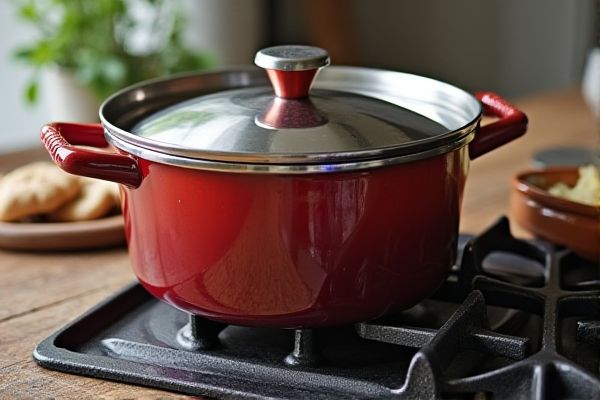
Enamel cast iron stock pots offer excellent heat retention and an attractive, non-reactive surface that prevents flavor transfer, while stainless steel pots provide superior durability, lighter weight, and resistance to corrosion without compromising heat conductivity. Explore the details of each material's advantages to determine which stock pot best suits your cooking needs.
Table of Comparison
| Feature | Enamel Cast Iron Stock Pot | Stainless Steel Stock Pot |
|---|---|---|
| Material | Cast iron with enamel coating | Stainless steel (usually 18/10 or 18/8) |
| Heat Retention | Excellent heat retention and even heating | Fast heating but less heat retention |
| Weight | Heavy and bulky | Lighter and easier to handle |
| Durability | Chip-resistant enamel, prone to cracking if dropped | Highly durable, resistant to dents and corrosion |
| Maintenance | Requires careful cleaning to avoid enamel damage | Dishwasher safe and low maintenance |
| Reactivity | Non-reactive surface due to enamel coating | Non-reactive, safe for acidic and alkaline foods |
| Price Range | Moderate to high | Affordable to moderate |
| Best Use | Slow cooking, braising, soups, and stews | Boiling, sauteing, and general cooking |
Introduction: Enamel Cast Iron vs Stainless Steel Stock Pots
Enamel cast iron stock pots offer superior heat retention and even heat distribution, ideal for slow cooking and simmering, while stainless steel stock pots excel in durability, resistance to corrosion, and ease of maintenance. Your choice depends on cooking style; enamel cast iron is perfect for recipes requiring consistent low heat, whereas stainless steel suits high-heat boiling and searing. Consider factors like weight, cleaning methods, and aesthetic preferences when deciding between these two versatile cookware materials.
Material Composition and Construction
Enamel cast iron stock pots feature a heavy cast iron core coated with a layer of enamel, offering excellent heat retention and durability while preventing rusting and sticking. Stainless steel stock pots are constructed from an alloy of iron, chromium, and nickel, providing superior corrosion resistance, lighter weight, and faster heating compared to enamel cast iron. Your choice depends on whether you prioritize heat retention and classic durability or corrosion resistance and ease of handling.
Heat Retention and Distribution
Enamel cast iron stock pots excel in heat retention and even distribution due to their thick, heavy construction, maintaining consistent temperatures for slow-cooked meals and simmering. Stainless steel stock pots heat up quickly but often have uneven heat distribution unless they feature an aluminum or copper core, which improves performance by preventing hotspots. The thermal properties of enamel cast iron make it ideal for dishes requiring long, steady heat, while stainless steel is suited for rapid temperature changes and quicker cooking tasks.
Durability and Longevity
Enamel cast iron stock pots offer exceptional durability with a robust cast iron core resistant to warping and high heat, while their enamel coating prevents rust and facilitates easy cleaning. Stainless steel stock pots provide impressive longevity through corrosion-resistant alloys that withstand frequent use and dishwasher cleaning without chipping or cracking. Both materials retain heat effectively, but stainless steel excels in resisting scratches and dents, making it ideal for intensive daily cooking environments.
Maintenance and Cleaning Requirements
Enamel cast iron stock pots require gentle cleaning with non-abrasive sponges to preserve their coated surface and prevent chipping, avoiding metal utensils and harsh detergents. Stainless steel stock pots offer more robust maintenance, allowing for scrubbers and dishwasher use without damage, making them ideal for heavy-duty kitchen tasks. Choosing your stock pot depends on your preference for easy upkeep and the type of cookware care routine you are comfortable maintaining.
Cooking Performance and Versatility
Enamel cast iron stock pots offer excellent heat retention and even heat distribution, making them ideal for slow-cooking, braising, and simmering, while their non-reactive enamel coating prevents flavor alteration with acidic ingredients. Stainless steel stock pots provide rapid heating and cooling, allowing precise temperature control and versatility for boiling, steaming, and searing across various cooking methods. Both materials excel in durability, but enamel cast iron enhances cooking performance for recipes requiring consistent heat, whereas stainless steel delivers greater adaptability for high-temperature and diverse culinary techniques.
Weight and Handling Differences
Enamel cast iron stock pots are significantly heavier due to their dense cast iron core, providing superior heat retention but requiring more effort to handle and lift. Stainless steel stock pots are lighter and easier to maneuver, making them ideal for frequent use or when agility in the kitchen is important. Your choice depends on whether you prioritize the stable, slow cooking performance of enamel cast iron or the lightweight convenience of stainless steel.
Cost Comparison and Value
Enamel cast iron stock pots typically cost more upfront due to their durable porcelain coating and heavyweight design, providing excellent heat retention and distribution. Stainless steel stock pots are generally more affordable, offering versatility, corrosion resistance, and easier maintenance but with less heat retention compared to enamel cast iron. The value of enamel cast iron lies in its longevity and aesthetic appeal, while stainless steel offers greater practicality and budget-friendly options for everyday cooking.
Health and Safety Considerations
Enamel cast iron stock pots offer a non-reactive, durable cooking surface that prevents metals from leaching into acidic foods, supporting your health with safety from toxic elements. Stainless steel stock pots are highly resistant to corrosion and do not chip or crack, ensuring long-lasting hygiene and preventing bacterial buildup. Both materials provide safe cooking benefits, but choosing enamel cast iron may reduce the risk of metallic taste and promote better overall food safety.
Which Stock Pot is Best for Your Kitchen?
Enamel cast iron stock pots excel in heat retention and even cooking, making them ideal for slow-simmered recipes and durable use. Stainless steel stock pots offer superior resistance to corrosion, lighter weight, and easier maintenance, perfect for everyday boiling and sauteing tasks. Choosing between enamel cast iron and stainless steel depends on your cooking style, durability preferences, and maintenance willingness for optimal kitchen performance.
 homyna.com
homyna.com